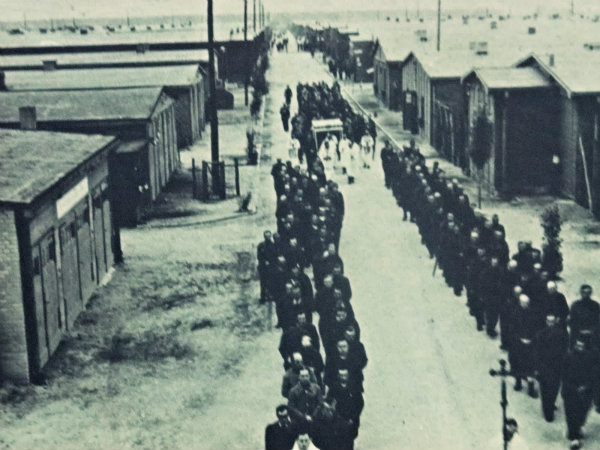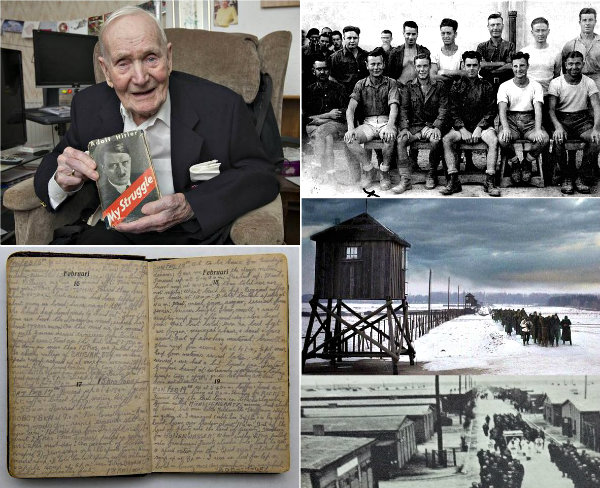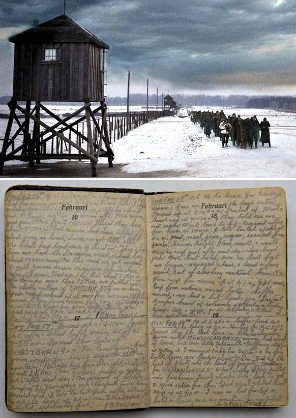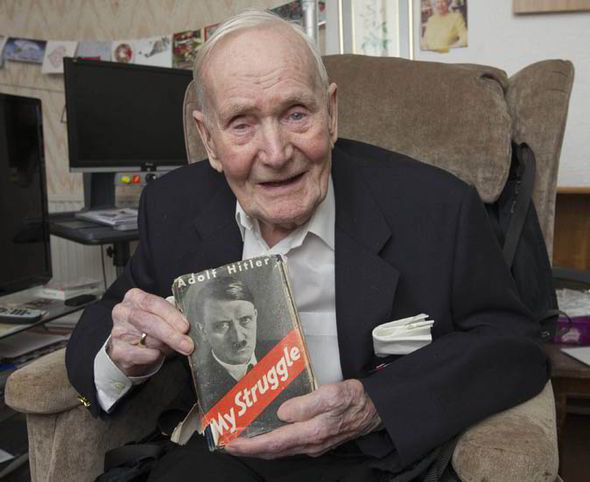Emaciated British POW Robbie Clark knew that lugging a 700-page book on what could be a march to death could be an unbearable pain but he also knew that the book bearing a youthful face of the German dictator Adolf Hitler could save his life if needed be.
German guards had given the books to them – English-translated copies of the Mein Kampf – beforehand in a move to sway them to their cause. Though Robbie Clark never read his copy, he stuffed it in his knapsack when the guards told them to pack up. They – some 80,000 British troops – were to embark on a more than 1,000-mile forced march across wintry Eastern Europe, a march which could spell the end of them.
Robbie Clark recounted that as they were about to embark on the death walk, he thought of bringing his English copy of the Mein Kampf just in case the Gestapo might spot him and when they do, seeing he had a copy of Hitler’s autobiography, they would let him off.
That practical mentality Robbie Clark carried with him along with a will that refused to go defeated carried him through “the longest march” of his life.
The Long/Death March of 1945
Robbie Clark, now 96 years old, is one of the last living POWs who made the march back from Poland’s stalags and eastern Germany during the bitter winter of 1945 – some seventy years ago.
A gunner serving with the 4th Durham Survey Regiment in the Royal Artillery, Robbie Clark was captured in the North African port city of Tobruk on June of 1942. Upon their capture, German Field Marshal Rommel personally told them “for you, the war is over”.
![Robbie Clark as a POW in Italy [second from left on the front row].](https://www.warhistoryonline.com/wp-content/uploads/sites/64/2015/01/Robbie-Clark-as-POW-in-Italy.jpg)
As he was healthy and had carpentry skills, Robbie Clark was made to work in groups which built and did repairs for the German war effort. When late 1944 rolled in, he and his fellow POWs learned that the tide of WWII was turning against Nazi Germany.
According to Clark, when they heard American bombers bombing in areas near to where they were, that gave them hope. The Germans had told them that the bombers wouldn’t get as far as where they were stationed but they did and it meant for the POWs that the Allies were on the winning side.

Even without radio or newspapers, he and his fellow POWs still heard about the events pertaining to D-Day and he personally thought they were good news. The group had hoped that their German guards would eventually desert and leave them on their own.
However, Hitler issued the orders that the Poland prison camps be evacuated with the British POWs taken back to Germany. Robbie Clark said that he and his fellow prisoners did not know where they were heading and they didn’t also think that their captors knew, either.
Even Hitler’s purpose for the evacuation was unclear. One implication could be that the German dictator didn’t want them joining Soviet’s Red Army and boosting the fighting forces that were in the east. Another explanation said that he had wanted to sue the POWs as human shields threatening the Allies to execute them if the latter did not agree to Germany’s terms for peace.
Or perhaps, it was just for the cruel intention of marching them to their deaths, killing them through the brutal cold, exhaustion and through starvation.
Whatever the reason or reasons behind it, the Long March or Death March of 1945 remains one of the darkest yet relatively unknown horrors which occurred within WWII history.
Winter’s Bite
On the wee hours of morning that fateful day, many of the men were woken up without any warning that they were to embark on a walk that could become to some, a walk to their deaths.
They were also given so little time to pack up some of their important belongings and were forced to start walking with only the clothes on their backs — clothes that were more than just rags topped with an equally ragged overcoat.
The still disheveled men were then placed together in groups of a hundred to two hundred and fifty. Surrounded with German guards, they were compelled to walk for up to twenty-five miles a day.
Some of the men had lost half of their normal body weights while in captivity and during that torturous event, they were driven to walk even to the point of starvation. What’s more, their German guards barely gave them enough rations that would, at least, give them a little strength as they make their way across the snow.
The winter that year is known as one of the coldest in the past century with temperatures going as low as -25C. The man also encountered gales and blizzards frequently.
many of the POWs forced on the walk died either on starvation, malnutrition and disease. Those who did live showed an amazingly strong human spirit in spite of the horrible conditions. One of these men was Robbie Clark.
His Story
Robbie Clark described that winter of the march as “bitterly cold”. He even recounted how at one point, he had to take the clothes of someone who had died — the coat and the boots. The WWII vet and survivor said that they had to do it to stay alive. He believes that the person he took the clothes from died out of starvation.
He added that he had to be extra careful when he took of the clothes from the deceased as he didn’t want the Germans to know. He never knew how they would react to scavenging.
Mr. Clark revealed that throughout the death walk, the motto that kept him going was “look after yourself because no one else will”. It was how he survived the grueling occurrence.
Robbie Clark was part of a group with about 120 men though the WWII vet wasn’t sure as the men around him changed as they were travelling west. Those POWs who fell down on the wayside due to hunger or injury were, according to him, treated harshly by their unsympathetic German guards.
He recounted how the SS would come and check on them and if they saw men who could not continue on, they shoot them. He never saw an actual shooting but he heard the gun shots.
Robbie Clark said that each man had to keep up with the pace of the group. When men did drop out of pace, unfortunately, he couldn’t do anything about it. There was only one thing in his mind — to continue on walking. Seeing the terrible things happening around him, Robbie Clark had one goal in mind: not to die in Poland.
Fascinatingly, the WWII vet was able to maintain a diary throughout the ordeal. In it, he wrote about the men’s struggles, their daily battle to survive. In it he wrote how he, along with the others, were desperate to find a church, factory or some kind of a factory at the end of the day for them to sleep in. He also wrote about their daily struggle for provision.
He recalled how finding potatoes were very vital to them. They would just peel the vegetables then eat them. At times, they would have fire and boil them but most of the time, they eat the potatoes raw along with carrots and beetroot.
There were times when they had the chance to stay near farms or houses where a woman could make them soup. Those were the better days of their march.
According to Robbie Clark, husks of bread, handfuls of oatmeal and watery German coffee were the mainstay of their daily diet. From time to time, a piece of fruit would be included but he said having it was their slice of luxury.
On a diary account dated February 18, 1945, the WII gunner wrote “Oh, to be home for Sunday dinners. Give me the dog’s ration.”
Marching without food were common days for the marchers that many of the men were forced to scavenge — reduced to eating rats, cats, dogs and even grass from the fringes.
Clark estimated how far they had walked in his diary through the road signs and telephone poles with distances posted on them along their route. Three weeks from when they started, he estimated that they had already covered 250 miles.
But days later, Robbie Clark was starting to feel the trauma brought by the long march. In his diary account, he wrote about how the walk was violent to bear making their journey hell with the men “utterly fed up”.
The Liberation
All in all, Robbie Clark and the other survivors were able to walk through some 1,000 miles. Their forced march ended April 23, 1945 when, in southern Germany, they were able to walk into a path of a US tank. Their captors suddenly disappeared and Clark, overwhelmed, along with his colleagues were rescued.
Robbie Clark was among the countless other soldiers and civilians taken into Nuremberg. There, he had his picture taken with German singer and outspoken Nazi critic Marlene Dietrich. Dietrich had been performing for the Allied soldiers before she headed back to Germany with the American liberation forces. When asked why she did it, her answer was simple — aus anstand or out of decency.
Just a week after Clark’s rescue, Hitler killed himself in his Berlin bunker. Eventually, Robbie Clark was flown to Belgium and finally to Britain where he was reunited with his family who had not heard from him or his whereabouts for the past three years.
Through his march, liberation, his return home and until now, Robbie Clark still possess that one book that he thought would someday save his life — his English copy of the Mein Kampf with its translated title spelled out in its front cover along with Hitler’s face. The translated title read My Struggle.


